
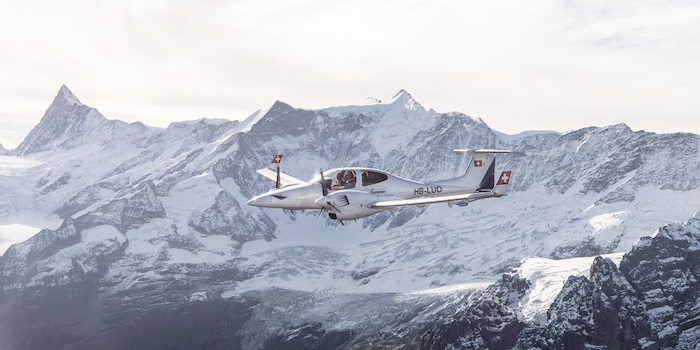
In the air with the new Sony RX0: How the mini camera from Sony is proving itself with professionals - Update: 15.01.2018
Kevin and Marius from Lauschsicht had the opportunity to take to the air with the new Sony RX0 and find out where the strengths of this miniature camera lie, how it performs in a professional production and in which areas it differs from the big competition, the GoPro.
We, the team at Lauschsicht, produce films for companies that want to provide insights into their world with moving images. In our projects, we not only try to keep our finger on the pulse in terms of content, we also look for new ways to capture unusual perspectives and gripping moments in production and post-production.
In our latest project, we are producing a film about the "fascination of flying" for Lufthansa Aviation Training. The primary aim is to provide an emotional and interesting insight into the world of flying. To make the fascinating combination of people, technology and nature tangible and thereby recruit new flight students.
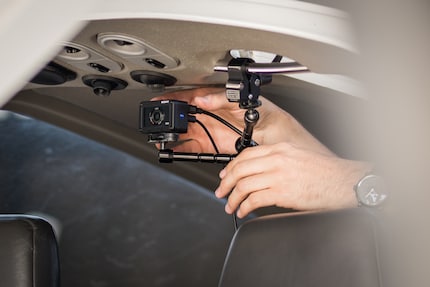
Mounting the Sony RX0 in the aircraft - thanks to the 1/4" inch thread on the bottom of the camera easier than with a GoPro
We usually film such projects in a small team, with equipment that is compact and mobile. This gives us the opportunity to be very agile on set. We use our Canon EOS C300 MKII as our main camera, but for this shoot in particular we also used the new Canon EOS C200, a Panasonic GH5 and GoPros - and the brand new Sony RX0.
The location
We only use the Sony RX0 when we are limited by the size of the other cameras. In the Cockpit of the small training aircraft, certain perspectives simply cannot be covered with a Canon EOS C300 MKII. This means that we have to rely on small but good quality cameras. The Sony RX0 combines these two requirements perfectly. In addition, in a production with several types of camera, we are dependent on being able to combine the film material well in the edit. This is better possible with the look and the Sony S-Log, a colour profile that captures a desaturated image, of the Sony RX0 than with a GoPro. Above the clouds, we are very often confronted with extremely high-contrast situations: Inside the relatively dark Cockpit and outside the blazing sun, snow mountains and white clouds. The ability to shoot in S-Log and thus have a greater dynamic range was very useful to us. Sony's S-Log ensures that all the information from the sensor is captured during the recording. However, film material with S-Log requires mandatory colour post-processing to ensure that the film looks as desired.
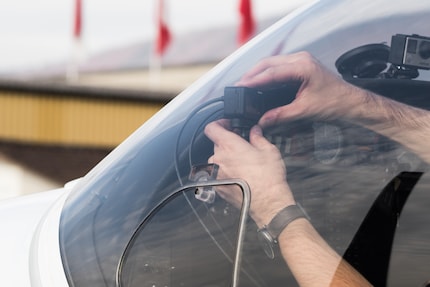
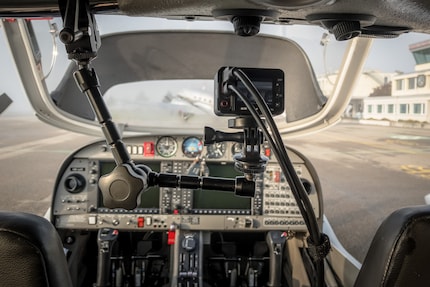
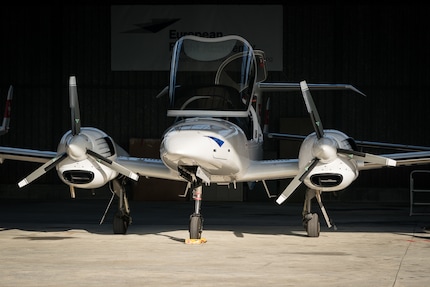
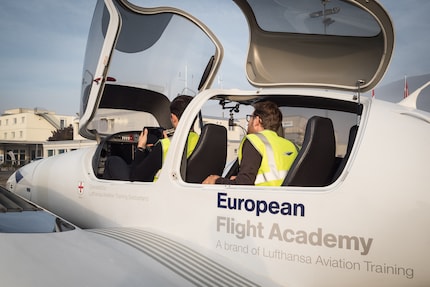
Kevin and Marius attaching and aligning the camera before the flight
Our setup
In order to be able to record Ultra HD (UHD) with the Sony RX0, we had to record with an external recorder. Unfortunately, the Sony RX0 only manages Full HD internally, which does not meet our requirements for such a production. With the Blackmagic Design Video Assist 4K recorder, we were able to record in UHD 25p ProRes 422HQ 10bit, in a quality that is not even possible with a GoPro Hero 6.
In addition, we were able to film in the tried-and-tested S-Log 2, which gives us a better opportunity to match the colours of the different cameras to each other, especially in post-production.
Due to the size of the built-in sensor, we have a depth of field, albeit minimal, for the first time with a camera of this size. A completely new option that we had with the Sony RX0 was the ability to set the focus manually. The focus can either be set to Near (0.5m - 1.0m) or Far (1m- ∞) with presets or manually from about 0.3m to infinity in steps. This can be very helpful.
We used small Magic Arms to attach the camera, the conventional 1/4" inch thread on the underside of the camera made it possible to mount the camera without additional plastic adapters, as we are used to from the GoPro. As we often start recording during take-off and can only stop again after landing, this results in long recording times. To avoid running the risk of the Sony RX0 battery giving up, we also operated the camera with an external battery. This summarises the following camera setup:
- Sony RX0 with HDMI Out directly to external recorder
- Recording mode Sony RX0: Manual mode, Sony S-Log 2, manual focus
- Batterypack via USB directly to Sony RX0
- Blackmagic Design Video Assist 4K Recorder 7" with 2x 128 GB Sandisk ExtremePro SDXC UHS-II
- Recording mode recorder: UHD 25P ProRes 422HQ 10Bit
- Mounting with Magic Arms and various clamps
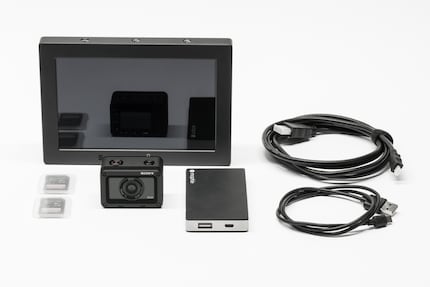
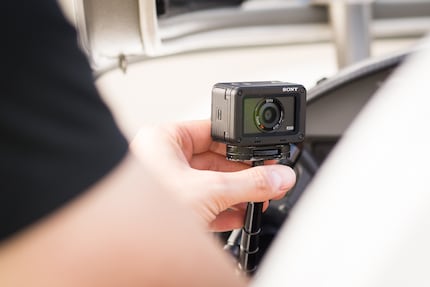
Insights production
The first thing we realise is that the camera in this setup is no longer small. The recorder is large and heavy, the external battery could be avoided, but in our case it was necessary with only one battery supplied. The camera had to be connected to an HDMI and USB cable at all times, which didn't make placement easy.
In terms of camera handling, the Sony RX0 does not differ greatly from other Sony cameras. The menu has a typical Sony structure. So anyone who has ever held a Sony camera before will quickly find their way around.
What takes some getting used to, however, is the extremely small font of the menu, which is due to the size of the camera and its screen. It is so small that the menu items are barely legible when setting up the camera outside in the sunshine and can be a real problem. The fact that we had an external recorder with a 7-inch screen made it possible for us to check focus, brightness and cropping. With the Sony RX0's built-in screen, this is not possible or only possible to a very limited extent.
What had to be taken into account was the amount of data generated when recording in UHD ProRes 422HQ 10bit. One minute of footage results in 5GB of data. For us, this meant we could record just 50 minutes with 2x 128GB SD cards.
Other than that, the setup with camera, external recorder and battery pack worked very reliably. Only the vibrations of the motors and the resulting horizontally staggered readout of the image sensor, the so-called rolling shutter effect, gave us some trouble.
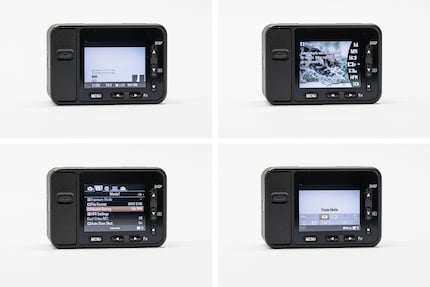
The menu of the Sony RX0 - due to the size of the screen, the individual menu items are extremely small. The histogram is also very small
Findings post production
The image of the Sony RX0 in UHD is impressive. The sharpness and look would give no idea how small the camera is. The focal length of the Sony RX0 is the equivalent of 24mm, while that of the GoPro is 14mm. That's a world of difference. While the viewer immediately recognises the "action wide-angle look" of the GoPro, the Sony RX0's focal length is much less wide-angled, which in turn results in almost no distortion in the image. It is therefore much closer to the image of a Sony PXW-FS5 or a Canon EOS C300 MKII.
In post-production, the difference to the GoPro is striking. With its 10-bit colour depth, the footage from the Sony RX0 gives us much more scope for colour correction. The Sony S-Log 2 makes it possible to use the Adobe Premiere Pro plugin "Filmconvert" to quickly adapt the footage to the recordings of other cameras.
What we have noticed is that the Sony RX0 develops a lot of noise relatively quickly in scenes with low light. It is therefore worth paying attention to the histogram and adjusting the exposure settings accordingly. It's better to go a little brighter than too dark - but without burning out the bright areas.
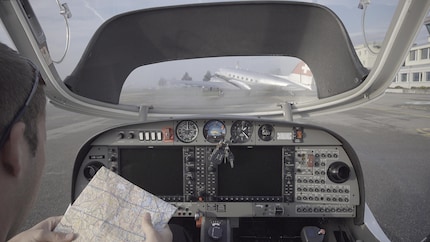
Raw footage as captured by the Sony RX0 in Sony S-Log 2
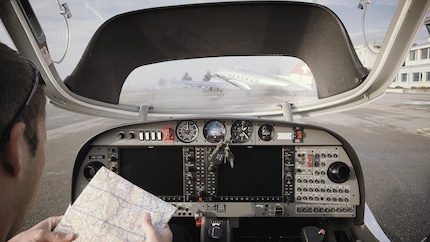
Footage of the Sony RX0 as it looks after normalising the colours
Comparison Sony RX0 vs. GoPro Hero 5
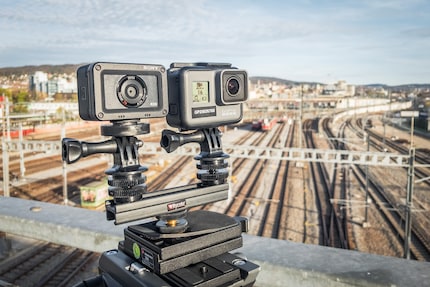
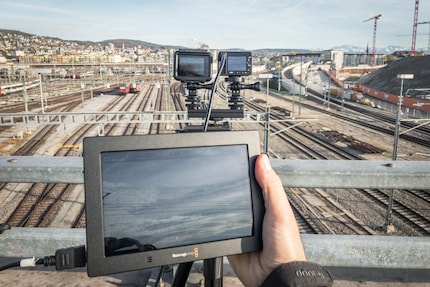
In order to obtain an image section that is as identical as possible, the two cameras were mounted directly next to each other
As it is difficult to compare two cameras with each other in an aircraft cockpit, let alone have the time to carry out various tests, we had to make up for this part. For the direct comparison, we stationed ourselves on the Hardbrücke with the Sony RX0 and the GoPro Hero 5. We ran through various shooting modes to find out where the differences lie between these cameras, which are very similar in appearance at least. We first compared the two UHD 25p images from the cameras. For this we needed the external recorder for the Sony RX0, which is not necessary for the GoPro Hero 5. We also tested the two cameras in automatic mode without a recorder. For the RX0, this means a resolution of FullHD (1080p). And finally, we carried out a dynamic test in a backlit situation. The findings:
- UHD of the Sony RX0 much sharper than that of the GoPro Hero 5 (but with recorder) [[image:10174999]] [[image:10175004]]
- FullHD internal of the Sony RX0 compared to the internal recording quality of the GoPro Hero 5 (4k) no chance - Sony RX0 has relatively strong moiré artefacts at FullHD internal [[image:10214600]] [[image:10214609]]
- Dynamic range of the Sony RX0 with Sony S-Log 2 larger than that of the GoPro Hero 5, but not by much [[image:10214610]] [[image:10214612]]
Difference between the Sony RX0 and the GoPro
Although the two cameras look very similar on the outside, they are in fact completely different. While the GoPro captures an extremely wide-angle image in which more or less everything is in focus, the Sony RX0 delivers a much more cinematic image. In other words, it is significantly less wide-angled, therefore not distorted and with a certain focus and depth of field. While the filmmaker can only set a kind of LOG profile on the GoPro via ProTune settings, the Sony offers the tried-and-tested S-Log, which a digital cinema camera also has. The GoPro has a touchscreen, the Sony RX0 does not. However, what should be decisive for most people is that the Sony RX0 only records a FullHD image internally.
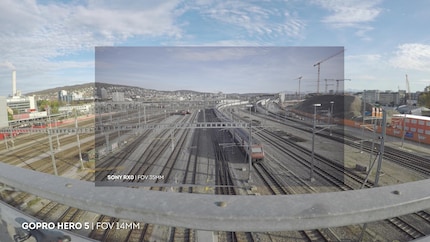
Comparison of focal lengths - the GoPro captures a much wider-angle image than the Sony RX0
Where do we see the Sony RX0 being used?
The Sony RX0 can really only fulfil its potential when used with an external recorder. Then it can be an extremely valuable camera that makes it possible to deliver a high-quality image even in extremely tight spaces, which is almost as good as a professional film camera such as the Sony PXW-FS5. With recording in ProRes 422HQ 10Bit, Sony is a big step ahead of the GoPro. However, there are situations where a cameraman cannot simply make a recorder disappear somewhere. Filmmakers are particularly reliant on the compactness of the camera when it comes to action and the Sony RX0 clearly has the edge over the GoPro. The Sony RX0 was not able to convince us with its internal recording, as the quality compromises compared to a GoPro are too great, there is a lack of image quality with moiré artefacts and simply a lack of resolution.
Update 15.01.2018: The finished video
Lauschsicht released the video for which they used the RX0 last weekend. We don't want to withhold it from you
.
<a href="https://lauschsicht.ch/" target="_blank">Lauschsicht</a> produces films for companies which want to give insights into their world with moving pictures. Thereby we maintain a very personal exchange with our customers and cover the whole production process from development to production and post-production. It is therefore almost always projects which pursue a very concrete communicative goal.

